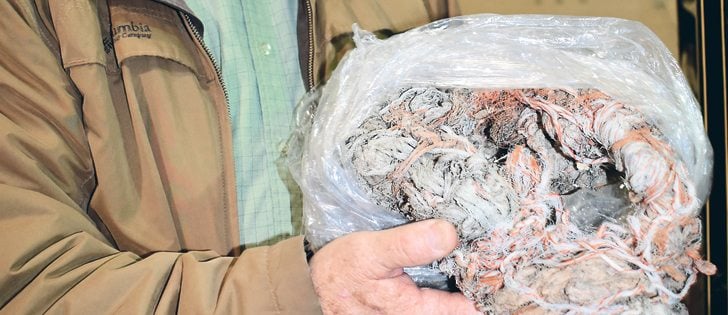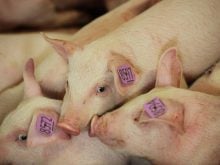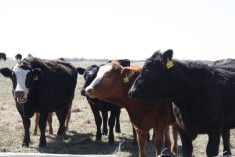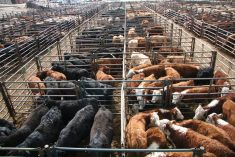FORT MACLEOD, Alta. — Bale net wrap is handy stuff when it comes to hay quality preservation, bale uniformity, ease of handling and protection from the elements.
However, it’s not quite so handy when net wrap ends up in a cow’s stomach, impedes digestion and eventually leads to the animal’s death.
Doug Leeds saw a first-hand example of the problem. The Claresholm, Alta., area rancher found a cow’s skeleton on his property earlier this year and the only thing well preserved was a large wad of net wrap in what was once the cow’s rumen.
Read Also

VIDEO: Ag in Motion documentary launches second season
The second season of the the Western Producer’s documentary series about Ag in Motion launched Oct. 8.
“She had eaten the stuff and packed it away. It’s actually as hard as a rock,” Leeds told those at the Alberta Beef Producers zone meeting in Fort Macleod Oct. 23. He brought the wad of material to illustrate his point.
Though there are recycling options for some types of agricultural plastic, such as twine and grain bags, the same is not true for net wrap. Most landfills don’t accept it, and it is illegal to burn it in Alberta, although that often happens in the absence of any other disposal method, said ABP delegate Assar Grinde of Bluffton.
Grinde compiled a paper for ABP members in which he asks whether the organization should support development of an agricultural plastics recycling program.
In most cases where the question was posed, the answer was yes.
In Fort Macleod, for example, members agreed that ABP should promote environmental re-use of agricultural plastic and increase awareness about the danger it poses to livestock.
At another ABP zone meeting in Innisfail, producers also moved to support a recycling program for grain bags, silage tarps and twines, in co-operation with other interested parties.
“The minute you use plastics, it is contaminated and the recyclers do not want contaminated plastic,” Curt Maki of Eckville, Alta., said at the Innisfail meeting.
“That is not feasible for us. The people who recycle plastic need to find new uses for it. They do not want to. They want more money to recycle it. They want us to pay.”
Grinde has done some research on agricultural plastics, including how they are dealt with in other provinces and countries. He suggested in a working paper that failure to address the problem could result in government intervention.
“Changes could be made (to government legislation), given environmental protection group pressures, if this were to become a flare point dealing with industry’s discussions about good stewardship,” Grinde wrote.
The trouble is, neither he nor the head of Alberta’s recycling council know the composition of net wrap.
“It varies widely between suppliers, and nobody currently has a technology to recycle it, so that’s why it’s the biggest problem,” Grinde said in an interview.
“It’s so efficient for wrapping bales,” he said.
“You can do it so much faster than twine. People really like using it, so the usage is increasing way faster than twine.
“So I think it’s going to become more and more of a problem and because we can’t recycle it, really the only option left is taking it to dumps.”
However, some landfills don’t accept the material because it becomes tangled in wheels and destroys bearings because the fibres are so slippery and fine.
Producers are left with the option of burying it or burning it.
Some producers put net-wrapped bales through a processor, shredding it into fine particles that cattle can eat.
However, that doesn’t solve the problem either, said Grinde.
“Especially in the winter, net wrap, once it goes through a freeze-thaw cycle, it gets all the straw frozen on and it’s almost impossible to take off,” he said.
“When you bale process, you just dump it in there and then it just shreds up. The cows eat it and the rest of it, I’d say the majority of it, gets wrapped up around the shredder at the bottom and then … people have to go in there with a cutting torch or a reciprocating saw and get it all cut off.”
After that, the pieces remain to be dealt with.
Municipalities, manufacturers, retailers, end-users and recyclers could form an association to oversee collection and distribution of a recycling levy, as is done with used oil and tires. That’s one possibility Grinde noted in his paper.
Technology, in the form of biodegradable plastics or even nutrient-infused wrap material, could provide a solution but that could be far down the road. The two agricultural plastics recycling programs in Alberta, operated by Mountain View County and Wheatland County, do not accept net wrap.


















